|
Tools of the Trade,Thematic Aspects of Designing
Draft report, 1996
An unpublished paper on the education of architects.
________________________________
In the fall of 1995 I spoke in the MIT lecture series on the role of the architect under the title "Palladio's Children". The drift of the lecture was that in Modern times, for the first time in the history of the profession, architects became designers for the everyday environment, designing houses, apartment buildings, workplaces, and commercial buildings. This was a departure from their traditional role of designer of the special - monumental - building. I pointed out that this momentous shift was never accompanied by a thorough re - examination of our attitude: in our teaching and our theorizing we still pretend to make special buildings.
At the end of the talk I ventured the opinion that such a re-examination might result in a very different kind of architectural education compared to what we have now.
Afterwards Stanford Anderson, Head of the Architecture Department at MIT, invited me to further explore the educational implications of my talk with the faculty ( my long standing colleagues and good friends ) of the department. From the meeting that ensued I concluded that I needed to spell out more clearly what exactly, in my opinion, this new education might be like. The report titled 'Tools of the Trade', was the result. It was kindly distributed through Anderson's headquarters.
Following are snippets of text from each of the dozen chapters, dealing with ten specific issues:
__________________________________________________________ ___
drawing: Christina Gryboyianni
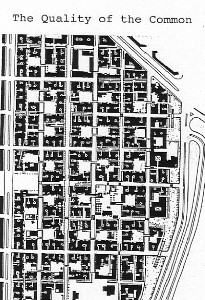 Intro: The Quality of the Common Intro: The Quality of the Common
snippets from the text:
.......On first sight the ten issues may seem disparate. Yet they all belong to the realm of the thematic. A territory, largely uncharted, but not necessarily unknown. I offer no map of it but argue it habitable and nourishing and therefore worthy of further exploration. All have to do with cooperation and coordination among designers.......
........Indeed, there is only a profession to the extent that we can formalize a common base of knowledge, method, and skills. We know as much, but do not speak of it. It somehow does not fit in the way we explain ourselves. We must hence explain ourselves anew.......
_______________________________________________________________________
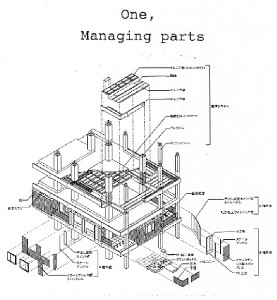 One, Managing Parts One, Managing Parts
Snippets from the text:
Even the most unruly and idiosyncratic architect expects those who design for him/her - underpaid talents perhaps, or voluntary student workers coming in for an exposure to the master's ways - to somehow absorb his way of making architecture........
........More and more, designing is done from a kit of parts......
.....Understanding how parts are managed and how they are generated through various stages -............. is essential knowledge to be passed on in schools
....Learning to work with libraries of parts and details has become a prerequisite for architectural designing. Education must catch up with this reality......
....Faculty should have their own teaching libraries...... A student may be exposed to a variety of libraries as she works with a variety of faculty. This is as well.
_______________________________________________________________________ _____
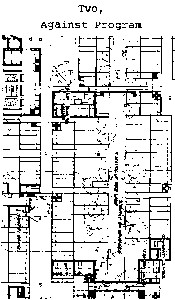 Two, Against Program Two, Against Program
Snippets from the text:.
.......Good architectural space allows human beings to settle and congregate in many ways for many purposes.
.....in the historic center of Amsterdam.....the Pulitzer hotel inhabits the houses it initially intended to replace.....Hotel rooms are in the houses,.......and look out on the canals or the enclosed garden.
The idea that program makes form is a vestige of the functionalist approach of Modernism.
...... Spatial order of the normal, the large, and the small is tied to the size of the human body and its social groupings. It offers an open ended mode of operation.......
....although form does not follow function anymore, programs are still given to kick off a design exercise..... there is another way......
_______________________________________________________________________ _____
a system of facade elements by Tom Hille
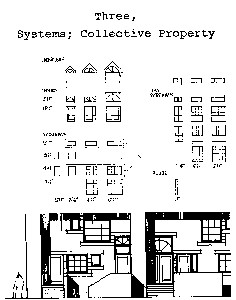 Three, Systems, Collective Property Three, Systems, Collective Property
Snippets from the text:
Systems can have a highly architectural content.......the systems concept can be interpreted so widely as to range from the classical orders to plumbing......The purpose may vary from the aesthetic and symbolic to the purely practical, but the mechanism is the same: Certain parties agree to work with certain parts in certain relations.....
....systems live in a social body.........develop, change, and bloom through use.
Today's world is multiform. The range of environmental systems has extended.
In their professional life, students will be exposed to a host of systems, both technical and architectural, material and spatial....
Architectural education therefore should sustain a consistent and comprehensive inquiry in the thematic properties of systems in the built environment....
These properties must also structure the way we devise exercises for students to develop systemic skills. The fact that one enters a social convention as well as a physical system must be recognized.
_______________________________________________________________________ ________________
drawing by Renee Chow
 Four, Patterns; Engaging the Client Four, Patterns; Engaging the Client
Snippets from the text:
.....There seems to be a an intuitive response to the pattern language that does not figure in today's architectural discourse. Alexander's work needs to be seen in the context of thematics to be fully appreciated......... Patterns are good thematic instruments.
....... excellent for a student's introduction to thematic form.
......Like systems and types, patterns become meaningful when shared among a group of designers.....
_______________________________________________________________________ ____________
detail 17 54 map of Paris, Abbe Jean Delagrive
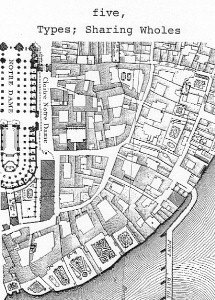 Five, Types, Sharing Wholes Five, Types, Sharing Wholes
Snippets from the text:
....Types remind us that wholes escape description and analysis........ By designing within a type we can recognize the wholeness without having to capture it in words, diagrams, or other descriptions.
.....type brings efficiency in interdisciplinary cooperation,......
The interdisciplinary coordination which is so much the type's strength is difficult to capture in an educational setting. But exercises in which spatial....interpretations of the type are explored and compared.....are worth doing.......
_______________________________________________________________________ _______________
from Casas Patronales, U.de Chile
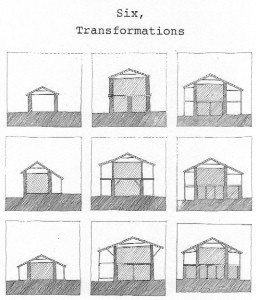 Six, Transformations Six, Transformations
Snippets from the text:
Types, Thematic systems, and patterns, all imply transformation.
The field's continuity as much as its structured complexity are derived from sustained processes of thematic modulation.
Adding move to move, simple forms can soon become quite complex.
Working with ( transformational) moves is as basic as working the scales when learning to play the piano.
_______________________________________________________________________ __
Frans van der Werf, Molenviet project: infill variations in base building
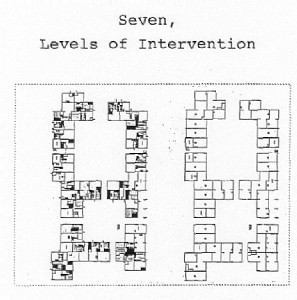 Seven, Levels of Intervention Seven, Levels of Intervention
Snippets from the text:
....built environment has a layered structure. There are levels of intervention we all understand....
...Level distinctions emerge wherever many actors intervene individually and must coordinate their efforts.....
....When thematic continuities are observed, the big building becomes a field among fields, known....by its internal structure.....
There is a tendency in architectural education to seek subjects that allow the student total control........(therefore) many forms....the office, the shopping mall, the apartment building.... do not figure in studio very much......
....these subjects only become interesting when approached thematically.
_______________________________________________________________________ ________________
 Eight, Capacity v. Function Eight, Capacity v. Function
Snippets from the text:
Assessing the capacity of a given space......links a given form to function. But ....the form must be there first.
Analysis of capacity assumes a distinction of levels....
Capacity analysis links designing on different levels. It offers a means to assure the hierarchical continuity of the environmental form without freezing it from top to bottom......
A computer program......can....tell us when we violate standards we have set ourselves..... To what levels of complexity automated capacity checking can be pushed ..... invites serious exploration.
_______________________________________________________________________ ________________
drawing Rene Chow, Grunsfeld Variations, zone analysis
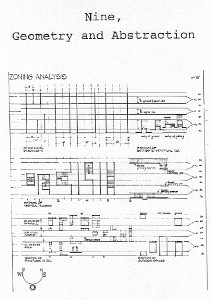 Nine, Geometry and Abstraction Nine, Geometry and Abstraction
Snippets from the text:
......It is good to remember that throughout history the building was there first. Geometry was an abstraction of the form; the form not an expression of geometry.
...Although pervasive today, geometry's use has little thematic meaning......
....we need ways to abstract spatial continuity, freely deployable and expandable....... The continuous field established by its inner structure has been imagined already by painters......
To this new purpose, the concept of zones may be formalized.....
...the student can move from the actual form organization towards its abstraction and back to new variations.......
_______________________________________________________________________ ________
grid used in Next21, Osaka project
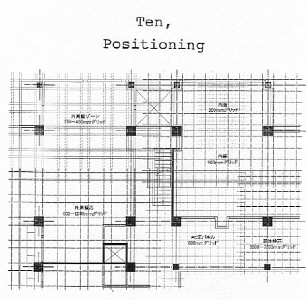 Ten, Positioning Ten, Positioning
Snippets from the text:
....traditional building practiceapplied...sophisticated systems of dimensioning, understood by all parties involved.......
We need new means to keep track of the distribution of parts in space and of their dimensional interdependence......
CAD systems that can be told....what position rules to apply.....can be efficient position managers....
management of data pertaining to all parts in a building is the key to future computer aided design. Not drawing, but data management will become the essence of CAD systems....
...computerized exercises allow learning with a minimum of labor.......Computer settings easily lend themselves to game - like situations.... that show the field as a thematic form.
_______________________________________________________________________ ________________
Souchow, humble administrator's garden and mansions
 Exit: Teaching Thematics Exit: Teaching Thematics
Snippets from the text:
....when engaging the field, we join in patterns of cooperation:....
Faculty who want to teach thematics will find that none of the aspects discussed in the previous chapters will fit easily, if at all, in the present studio format........New ways of teaching must be invented.
.Exercises in skills and methods are best separated from a discussion of values. Their subject is manipulation of form.
Those imbued with (post) modern values may find it difficult to take seriously the idea that the fate of architecture depends on the contemplation of the ordinary and the cultivation of the common. Moreover, the academic mind, trained to ask questions and mistrust convictions, may be reluctant to accept the proposed direction. Yet the latter may appreciate that, to see the way I suggest, some hard questions must be dealt with first. The former may remember how, not long ago, the avant-garde took pride in pursuing what many thought was beyond the pale.
It seems to me that the issues raised in this paper are still relevant. I remain interested in discussing the suggestions made here. (john@habraken.org)
|